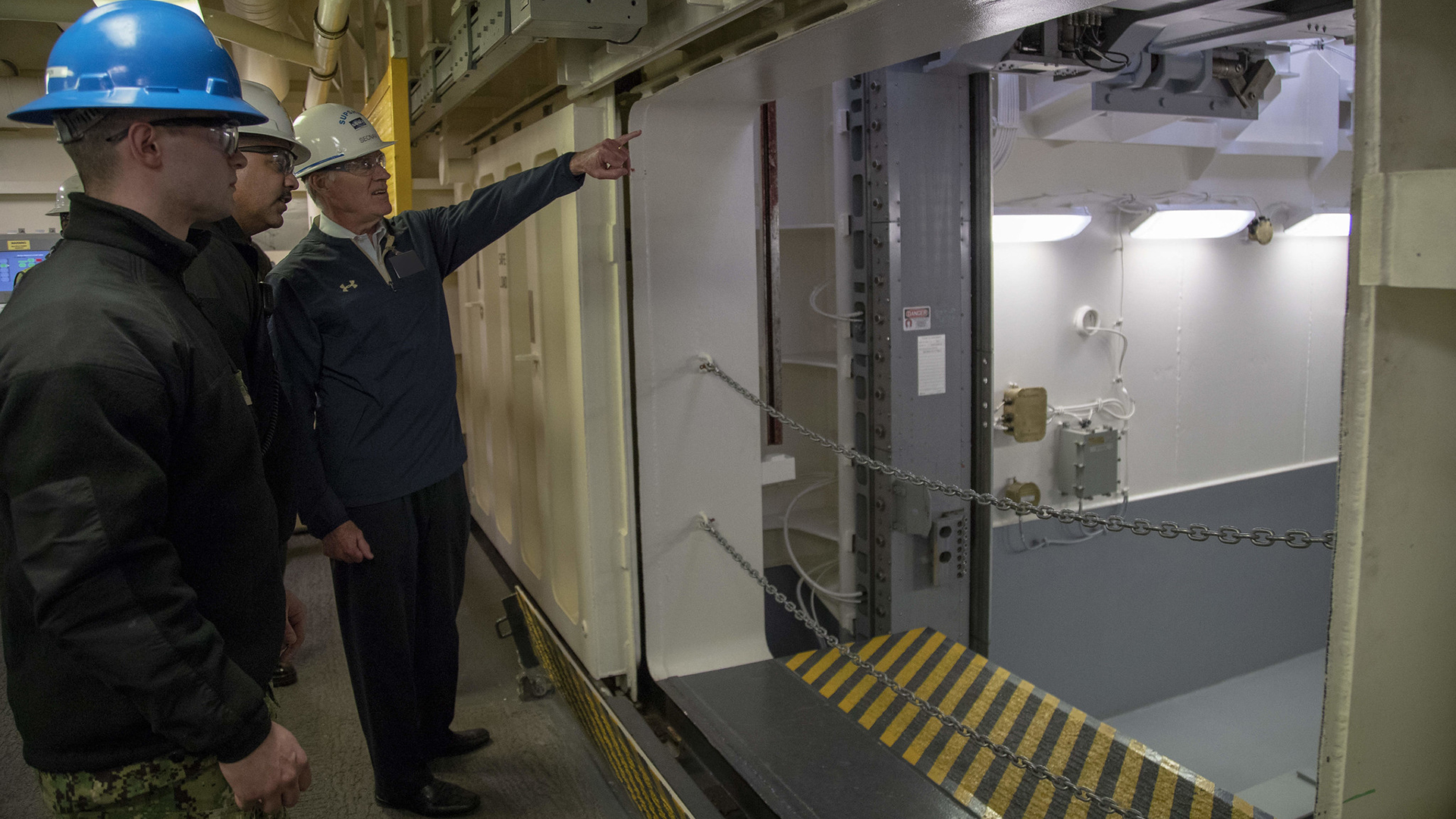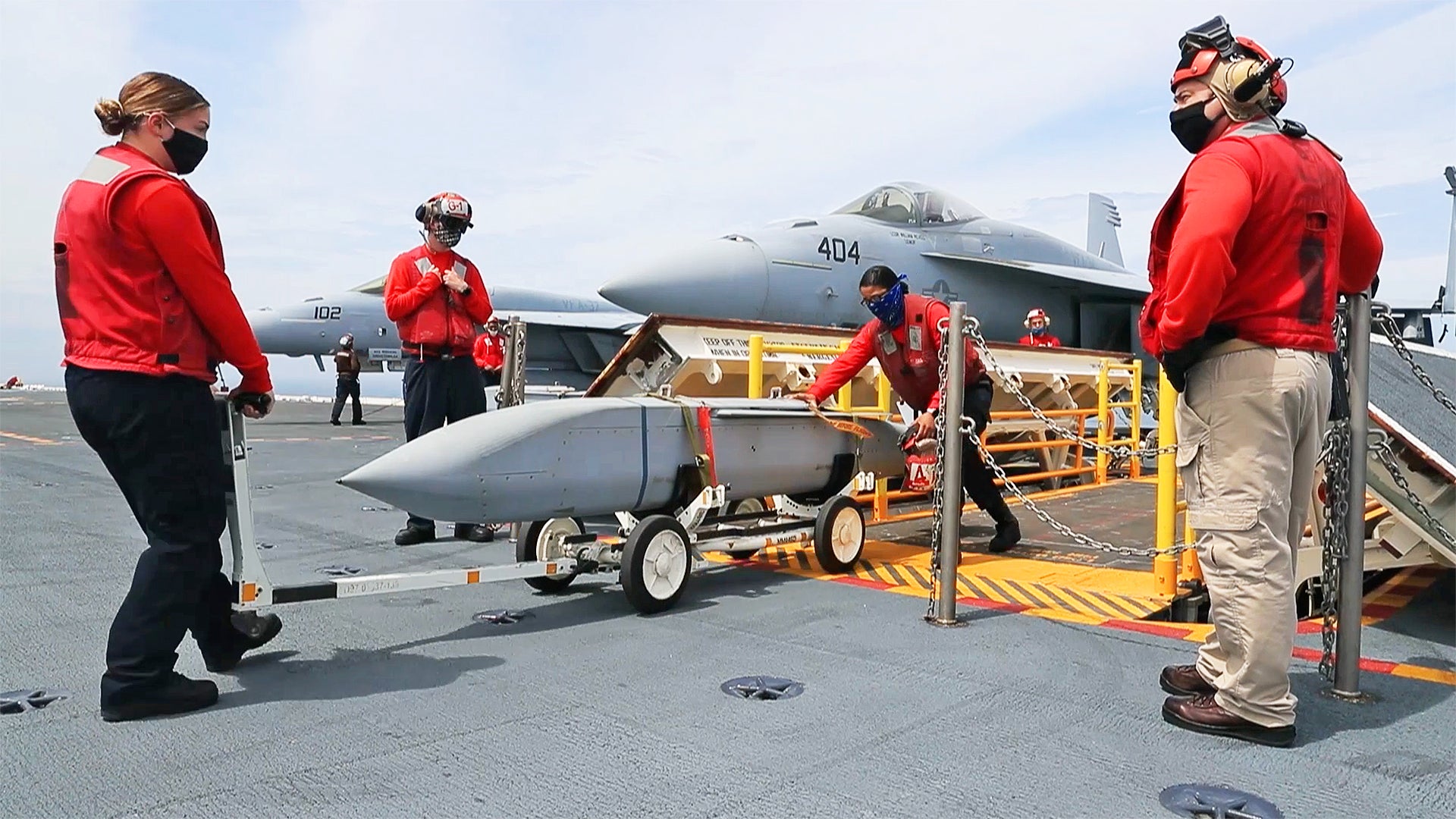The U.S. Navy announced today that the final advanced weapons elevator on the USS Gerald R. Ford has been declared fully functional. The 11 elevators on the service’s newest aircraft carrier, which permit movement of ordnance from the ship’s magazines to the aircraft, have been a continuing problem since before the Ford was officially commissioned in 2017.
With the announcement from the Program Executive Office – Aircraft Carriers, the Navy has kept a commitment it made this past summer to complete the elevators in 2021, and it has removed a major obstacle to the carrier’s expected first deployment in 2022. As recently as August 2021, only seven of the elevators were considered fully operational. At that time, the Navy announced its expectation that the remaining elevators would be functional by the end of 2021.

The elevators are one of several new technologies incorporated into the carrier. Traditional carrier elevators use hydraulics and mechanical linkages — cables — to raise and lower platforms. According to Naval Sea Systems Command (NAVSEA), the Ford’s advanced elevators replace those maintenance-intensive and comparatively slow elevators with ones run by electromagnetic motors. With fewer moving parts, the system should in principle be less complex to operate. However, the manufacturing tolerances for such a system require greater accuracy and precision than a purely mechanical one.
According to the Congressional Research Service, the Navy and builders struggled to incorporate such tolerances and, in 2019, the Navy told Bloomberg that as many as 70 elevator doors and 17 hatches did not meet requirements because of how changes to the ship have evolved. Without fully functioning weapons elevators, a carrier will struggle to generate the desired sortie rate because it will take too long to move weapons from the magazines to aircraft on deck.
The elevators are not the only major problem the Ford has had to resolve. Among other issues, the Navy has addressed the ship’s waste management — its toilets overflow — as well as propulsion and electrical systems. In April, the Navy announced that the ship’s formerly troublesome Advanced Arresting Gear and Electromagnetic Aircraft Launch System had accumulated 8,000 launch and recovery cycles, an important turnaround for another system that had plagued the carrier from early on, and another that directly affects how quickly the carrier can launch and recover aircraft.

Not all is right with the ship, however. It is years away from being able to operate F-35Cs, the Navy’s carrier-borne version of the Joint Strike Fighter. The Navy’s explanation for this, according to Breaking Defense, is that Ford was laid down in November 2009, with a design that had been finalized even earlier, while the F-35C was still in relatively early development. The upshot is that at least the first two carriers in the Ford class — the Gerald R. Ford and the future John F. Kennedy — will need retrofitting and upgrades to carry the Navy’s most advanced strike fighters. In a December 2021 report, the Congressional Research Service estimated the cost of the Ford at $13.3 billion, and the future Kennedy at $11.9 billion.
According to a November 2020 contract award, the Navy has committed some $285 million to ensuring “a single-phase delivery approach to meet both Fleet requirements and a congressional mandate of ensuring that CVN 79 [the Kennedy] is capable of operating and deploying Joint Strike Fighter (F-35C) aircraft before completing the post-shakedown availability.” The award specified a targeted completion date of June 2024.
According to Dailypress.com, the Ford is expected to be ready for F-35Cs in 2025. The ship needs changes to multiple systems, including jet-blast deflectors, handling-and-stowage facilities, and lithium-ion battery handling gear.
The carrier’s development under former Defense Secretary Donald Rumsfeld’s “Revolution in Military Affairs” created ample amounts of risk in the hopes of generating considerable opportunity. For the Navy, abandoning its traditional “spiral development” approach — building incremental improvements on established systems — clearly has slowed the replacement of the Nimitz-class aircraft carriers that remain the backbone of the fleet. In October 2019, then-Secretary of the Navy Richard Spencer lost his cool about Congress and shipbuilder Huntington Ingalls Industries at a Brookings Institute event in Washington, as public criticism of the problems reached a crescendo. Spencer had previously suggested in January 2019 then-President Donald Trump should fire him if the elevators were not fixed quickly.
So, even if the Navy succeeds at its current plan to deploy the Ford
for the first time in 2022 — four years late — it will be some time before the service will be able to judge if the tradeoff was ultimately worth it.
Contact the author: Brian@thedrive.com.
